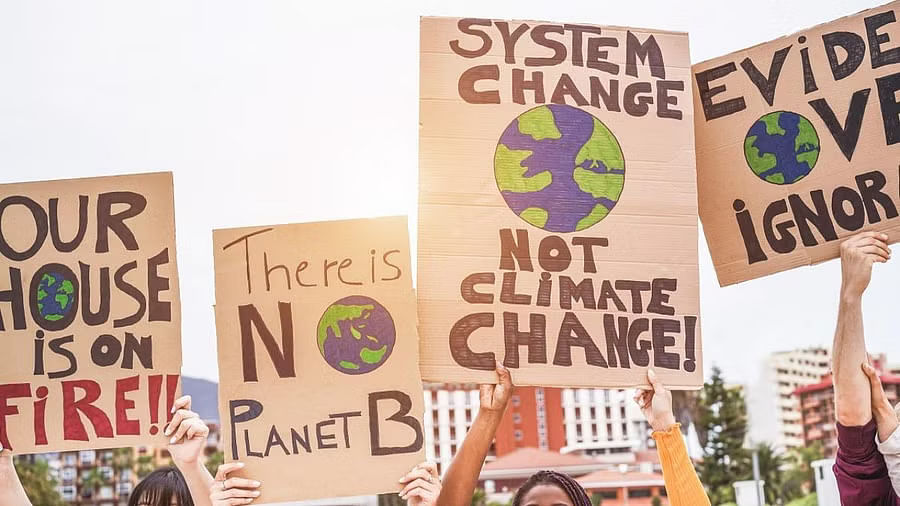
Whatever gains in climate action were achieved until the Covid-19 period have been undone due to geopolitical tensions, namely the Ukraine-Russia conflict, the Israeli Hamas war, and many more conflicts such as the Iranian-backed Houthi attack on trading ships through the Red Sea, Israel-Hezbollah clashes, etc.
Credit: iStock Photo
Copernicus Climate Change Service (C3S) has found that June 2024 marks the thirteenth month of global temperature above 1.5 degrees Celsius (averaging at 1.64 degrees Celsius) above pre-industrial 1850–1900 levels. Thus, extreme climate events such as droughts, heat waves, wildfires, incessant rains and flooding, and cyclones are more frequent and destructive. Ahead of the climate conference, COP-29, in Baku, Azerbaijan, in November 2024, the United Nations Climate Change Executive Secretary, in a review at Bonn, observed that countries have taken very little climate action to stop further warming.
COP 29 should take bold steps to cut greenhouse gas emissions, especially in the top five emitting countries. Whatever gains in climate action were achieved until the Covid-19 period have been undone due to geopolitical tensions, namely the Ukraine-Russia conflict, the Israeli Hamas war, and many more conflicts such as the Iranian-backed Houthi attack on trading ships through the Red Sea, Israel-Hezbollah clashes, etc. China, the United States, and other developed nations have been considering defence as a priority sector as compared to climate action.
In an address to the leader of the North Atlantic Treaty Organisation (NATO) in Washington, US President Joe Biden, who is under pressure from Democrats to withdraw from the November 4 presidential race, has shown energy and vigour and pledged more military support to Ukraine as well as strengthening the western alliance. The declaration of NATO’s conference accused Beijing of becoming “a decisive enabler of Russia’s war against Ukraine” and demanded that it halt shipments of weapon components and critical technology for rebuilding the Russian military. A spokesperson for the Chinese Foreign Ministry in turn warned the alliance not to bring “chaos” to Asia and maintained that China’s trade with Russia is legitimate, reasonable, and based on World Trade Organisation rules. China has provided computer chips, advanced software, and the components needed for Russia to build a defence industrial base that churns out faulty and outdated equipment.
Amidst sanctions, Russia had to rework its strategy for the oil and gas market. The supply of Russian gas to Europe through Nord Streams pipelines dipped, though it has subsequently recovered and registered a 23% jump in June 2024. European countries, for the remaining requirement, were dependent on the transport of Middle East oil through ships and trains. With oil replacing gas, gains in climate action were lost, and greenhouse gas emissions surged. Russia exported its oil and gas to India, China, and many other Asian countries at concessional rates to earn money to fund the war. Even rupee-ruble trade was facilitated between the two countries. Meeting the surge in power demand is the largely cited reason for the increased production of oil and gas. Cold countries need power for heating their houses, hot countries need it for cooling, and everyone needs it for industrial growth and development. Since renewable energy is not developed at speed and scale, the dependency on fossil fuel-based power is going up with the surge in demand.
The infrastructure for new oil and gas extraction in Russia’s Far East region is being upgraded for additional earnings to fund the war. These are strategic projects and have been key topics for discussion during our Prime Minister’s recent visit to Russia. In addition to diversifying the Baltic energy reserve towards India and China, the Eastern Maritime Corridor is being developed for shipping from the Far East’s Vladivostok through the eastern Pacific and up to Indian ports at Kolkata, Odhisa, and Chennai. Nuclear ice-breaking vessels are working to cut the ice, which has already been melting due to global warming, to make a shorter route operational for shipping to Europe. Already, 17% of Russia’s oil and 83% of its gas come from the Arctic region. The
opening of more sea routes due to the melting of ice and glaciers will cut costs and boost demand.
US oil and gas extraction has hit a record high in 2023–24. It reached an all-time high of 13.2 million barrels a day in September 2023. The US accounts for 80% of global expansion this year. This has resulted in a fall in prices and a surge in demand. This is likely to persist with a high likelihood of Donald Trump returning to the White House; he is a known climate sceptic and a proponent of fossil fuels. China, the world’s highest greenhouse gas emitter, has constructed more coal power plants as compared to the rest of the world. It has consumed
4.5 billion tonnes of coal this year, which
is again a record.
The C3S report and increasing consumption of fossil fuels have to be viewed seriously, and COP-29 at Baku must resolve to slow down fossil fuel-based development and reforest the areas where tree covers were lost in the last six to seven decades. Protecting big forest land areas of the Amazon, Congo, Alaska, Canada’s temperate forests, Taiga in Russia, and equatorial forests of Papua New Guinea and enhancing their circumference by taking up regeneration measures in adjoining lands that have been mercilessly exploited over decades has to be a focus. These mega-forests play the role of carbon sinks that must be restored. This task cannot only be left to the countries where forests are situated. Others must chip in under the umbrella organisation of UNCCC.
(The writer is a retired principal chief conservator of forests, Karnataka)